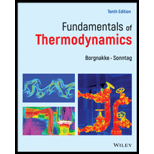
Fundamentals Of Thermodynamics
10th Edition
ISBN: 9781119494966
Author: Borgnakke, C. (claus), Sonntag, Richard Edwin, Author.
Publisher: Wiley,
expand_more
expand_more
format_list_bulleted
Question
error_outline
This textbook solution is under construction.
Students have asked these similar questions
Example 6.1
Heat is transferred to a heat engine from a furnace at a rate of 80 MW.
IF the rate of waste heat rejection to a nearby river is 50MW, determine
the net power output and the thermal efficiency for this heat engine.
Choose correct answer:
Refrigerators and heat pumps operate on the same cycle but differ in their objectives.
Select one:
True
False
Provide correct explanation
Knowledge Booster
Learn more about
Need a deep-dive on the concept behind this application? Look no further. Learn more about this topic, mechanical-engineering and related others by exploring similar questions and additional content below.Similar questions
- Refrigerators currently being manufactured in the United States are using______as their refrigerant.arrow_forwardA heat engine has a solar collector receiving 600 Btu/h per square foot, insidewhich a transfer medium is heated to 800 R. The collected energy powers aheat engine that rejects heat at 100 F. If the heat engine should deliver 8500Btu/h, what is the minimum size (area) of the solar collector?arrow_forward3.) When a gas surrounded by air is compressed or expands adiabatically, its temperature rises or decreased even though there is no heat input or dissipated to the gas. Where does the energy come from to raise or lower the temperature? 4.) Why must a room air conditioner be placed in a window rather than just set on the floor and plugged in? Why can a refrigerator be set on the floor and plugged in?arrow_forward
- A geothermal heat pump with a coefficient of performance of 1.3 supplies a building with 48000 BTU/hr of heat. Assuming a $0.20/kWh electricity rate. Provide responses to the following questions about this system: a. How much would it cost per month to supply heat at a rate of 48000 BTU/hr using a basic electrical resistance heater? b. In that month, how much heat is extracted from the earth by the heat pump, in kWh? c. What is the monthly savings associated with using this heat pump vs a basic electrical resistive heater?arrow_forwardplease show the complete solution thank you...arrow_forwardSolve last 3 partsarrow_forward
- 6.24 A heat pump system operates between temperature limits of -5 and 18°C. The heating load of the space is 48,000 Btu/h and the COP of the heat pump is estimated to be 1.7. Determine (a) the power input, (b) the rate of heat absorbed from the cold environment, and (c) the maximum possible COP of this heat pump.arrow_forwardThis is Problem 13 of Chapter 3 in Sustainable Energy by Richard Dunlap, 2nd Edition. I need help solving it: A coal-fired generating station has an efficiency of 38% and produces an average electrical output of 1000 MWe.(a) How much coal does it burn per second (kg/s)? Assume the coal is bituminous.(b) How much heat (in joules) is released to the environment per second?(c) How many liters of water at 20°C could the heat in part (b) boil (at STP) per second? For c, here is my idea: use Q = mc(change in T). Here change in T is (100 C - 20 C) or 80 C and c = 4200 J/(kg C) so I can solve for m. Question: I need the density of water to find liters, but density changes with temperature. So, do I use the regular 1000 kg/m^3 or something else?arrow_forward2. Between 300K and 600K is the operating temperature of a pair of heat pumps connected in series. The efficiency of the second heat pump is three times that of the first. Find the input work for the first and second heat pumps if the second heat pump absorbs 20kW of heat and the heat release in the first heat pump is the same.arrow_forward
- Nonearrow_forwardI. 1. During a cyclic process, a heat engine absorbs 500 J of heat from a hot reservoir, does work and ejects an amount of heat 300 J into the surroundings (cold reservoir). Calculate the efficiency of the heat engine?arrow_forward3.Two Carnot heat engines run in series with the efficiency of first engine is 1/k times the second. If the thermal reservoir at low and high temperatures were denoted by TL and TH, find the simplified ratio of heat absorbed to heat rejected by the second heat engine in terms of TL, TH and k only.arrow_forward
arrow_back_ios
SEE MORE QUESTIONS
arrow_forward_ios
Recommended textbooks for you
 Refrigeration and Air Conditioning Technology (Mi...Mechanical EngineeringISBN:9781305578296Author:John Tomczyk, Eugene Silberstein, Bill Whitman, Bill JohnsonPublisher:Cengage Learning
Refrigeration and Air Conditioning Technology (Mi...Mechanical EngineeringISBN:9781305578296Author:John Tomczyk, Eugene Silberstein, Bill Whitman, Bill JohnsonPublisher:Cengage Learning

Refrigeration and Air Conditioning Technology (Mi...
Mechanical Engineering
ISBN:9781305578296
Author:John Tomczyk, Eugene Silberstein, Bill Whitman, Bill Johnson
Publisher:Cengage Learning
The Refrigeration Cycle Explained - The Four Major Components; Author: HVAC Know It All;https://www.youtube.com/watch?v=zfciSvOZDUY;License: Standard YouTube License, CC-BY